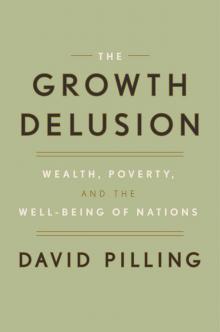- Home
- David Pilling
The Growth Delusion Page 12
The Growth Delusion Read online
Page 12
India’s leaders were almost suspicious of growth, fearing that if some people benefited first it could lead to social unrest. In 1972 Prime Minister Indira Gandhi, Nehru’s daughter, lashed out at what she called growthmanship. Giving “undivided attention to the maximization of GNP can be dangerous,” she said in a speech, “for the results are almost always social and political unrest.”6
If India’s policy was to avoid excessive growth, it was working like a charm. The country became stuck in what became known derisively as the Hindu rate of growth. In the forty years following independence in 1947, annual GDP growth rose at around 3.5 percent. That doesn’t sound too bad until you realize that the population was expanding at about 2 percent. What matters is income per capita. In those terms, India was growing at barely above 1 percent, nowhere near enough to make a dent in its grinding poverty. There was no Miracle on the Ganges.
* * *
—
In the late 1980s India’s economy bounced from crisis to crisis and foreign exchange reserves dwindled to almost nothing. With its back to the wall, the government finally embraced economic reform. In 1991 Manmohan Singh, the finance minister, was empowered to implement a radical series of measures: he cut import tariffs, slashed taxes, and removed barriers to foreign investment. Most important, he dismantled what was known as the License Raj, the maddeningly bureaucratic system of permits, licenses, and regulations that controlled industry and had effectively restricted moneymaking opportunities to a coterie of crony capitalists. Through the 1990s growth began to pick up, rising steadily to above 7 percent, a rate at which an economy doubles in size every decade. Successive governments introduced policies to deepen the reforms, opening up more areas of the economy to market forces and foreign investment. By 2016 India was vying with China as the fastest-growing large economy on earth.7
In a 2010 speech to the Lok Sabha, India’s lower house of parliament, Jagdish Bhagwati, a prominent and rambunctious Indian economist with a twinkle of mischief in his eye, praised the impact of growth on the life of ordinary Indians, some 200 million of whom he said had been lifted out of poverty. The architects of liberal reform, he said, had never intended to create growth for growth’s sake. Rather growth was viewed as an enabler, a means of attacking poverty. He denied that such policies had anything to do with the discredited trickle-down economics popularized by Ronald Reagan with his aggressive tax cuts for the rich. Instead, he told parliament, growth was “a strategy for pulling the poor out of poverty through gainful employment, not as an end in itself.”
Bhagwati’s position was different from that of another prominent Indian economist, Amartya Sen, recipient of the 1998 Nobel Prize for economics and a contemporary of Bhagwati’s at Cambridge back in the 1950s. (Manmohan Singh, the architect of India’s reforms, also studied economics at Cambridge at the same time.) Sen has railed against “market fundamentalism” and stressed instead what he calls social capabilities, a term that boils down to an individual’s freedom and capacity to achieve things: from the basics, such as accessing food, education and health, to the more ambitious, such as expressing a political opinion, participating in the democratic process, or choosing how to live one’s life free from racial or gender prejudice.
When he was about ten years old, the young Sen was playing in the family garden in Dhaka, now the capital of Bangladesh but then a city in India before partition.8 Suddenly a man came screaming into the garden with a knife wound in his back. Those were the days of communal violence between Hindus and Muslims. The knifed man, a laborer called Kader Mia, had come to work in a predominantly Hindu neighborhood and had been set upon by local thugs. The traumatized young Sen gave him water, and his father rushed the injured man to the hospital. On the way, Kader Mia explained that his wife had urged him not to come to the Hindu area in such troubled times, but that he had had no choice since he needed even the pittance he could earn as a day laborer to buy food for his family. Otherwise they would have had nothing to eat. “The penalty of his economic unfreedom,” writes Sen, “turned out to be death, which occurred later on in the hospital.” For the boy who would grow up to become a Nobel economist, the incident crystallized the connection between poverty and lack of freedom.
According to Sen, the purpose of development, a concept too often crudely reduced to an economic statistic, is “expanding the real freedoms that people enjoy.”9 Economic growth, he writes, can provide individuals with the wherewithal to escape “unfreedoms,” the lack of choice to mold the contours of one’s life. It so happens, Sen argues, that expanding people’s freedom by, for example, ensuring they have access to basic rights such as health and literacy, is also good for growth. But in Sen’s writing, liberty—freedom from unfreedoms—should be seen as a requisite of development, not a prerequisite for growth.
The positions of Bhagwati and Sen may seem like two sides of the same coin: one argues that growth can alleviate poverty, the other that poverty inhibits freedom. Yet the apparent compatibility of their arguments has not prevented a bad-tempered, not to say vicious, feud between the two. After Bhagwati’s speech to parliament, Sen told the Financial Times that India’s government was “stupid” for prioritizing double-digit growth when tens of millions of Indians were undernourished.10
Bhagwati, who mocks Sen as the “Mother Teresa of Economics,” accused him of being a latecomer to the virtues of growth and antagonistic to necessary pro-growth reforms. “Significant redistribution in India could not have preceded growth as there were too few rich and too many poor,” he wrote. If you want to cut up a pie evenly, you first have to have a pie. Sen, he writes in typically vituperative style, “puts the cart before the horse; and the cart is a dilapidated jalopy!”
The argument between the warring economists intensified during the 2013 election campaign. This pitted Rahul Gandhi, scion of the Nehru-Gandhi dynasty that had dominated Indian politics since independence, against Narendra Modi, an outsider and son of a tea seller. Modi had been the controversial governor of Gujarat province, praised by some for his pro-business, no-nonsense style, but excoriated by others for allegedly standing by during a 2002 massacre of nearly 800 Muslims. Modi was a polarizing figure, and Bhagwati and Sen were duly polarized. Bhagwati supported Modi and Sen did not.
More generally, Sen was among the many who wondered what all the headline growth in India was for. He was appalled by both the continued misery of its poorest people, including what he alleged was widespread malnutrition,11 and by the excesses of its wealthy. Rich Indians were known for extraordinary conspicuous consumption: one Indian mining tycoon invited 50,000 guests to his daughter’s wedding at a mock-Tudor castle in Bangalore at a cost of $80 million.12 The country boasted a growing number of billionaires, some of whom did not exactly wear their social consciences on their sleeves. In Mumbai, a city where millions live in squalid slums, Mukesh Ambani, the wealthiest man in India, built a twenty-seven-story house, a “vertical palace” reputed to have cost $1 billion. Sen pointed to Bangladesh, a poorer country than India but one where, he argued, the poor (especially women) enjoyed higher life expectancy, better immunization rates, and more control over reproduction than their Indian counterparts.13 In other words, Sen argued, Bangladesh had achieved more development with less GDP.
Bhagwati disputes Sen’s assumptions. Instead, he highlights what he says are reduced poverty numbers and the advances in social indicators achieved by Indian growth. Growth, he says, “is a necessary condition, not a sufficient condition. The more you have of GDP, the more capability you have—if you have a good intention—to indulge it.”
The intellectual spat between the two men can seem petty. Boiled down to its essence, Bhagwati says you need growth to generate funds to spend on health and education, while Sen says you need decent health and education to create the necessary conditions for growth. Their dispute has more to do with the order in which things take place than with the desired outcome.
> In the court of academia their argument rages on, but in the court of public opinion the verdict was somewhat clearer. Narendra Modi won a thumping victory. I followed that election closely, visiting India several times in 2014, the year the drama unfolded. A couple of weeks before voting took place, when Modi’s victory already looked certain, I wrote that the downfall of the long-serving Congress Party lay in not recognizing how much India had changed. Fifteen years of growth had not yet worked miracles, but it had reduced the number of people who were desperately poor. That had cut their reliance on Congress’s patrician brand of politics.
“Most Indians,” I wrote, “are no longer satisfied with the make-work schemes or food handouts in which Congress has increasingly specialized. Many have caught the whiff of a better life. Now they want jobs and opportunity. Even those who have not yet clawed their way on to the bottom rung of the aspirational ladder have seen what it looks like, courtesy of the satellite television channels that beam images of a middle-class life into even the most benighted corners of the country.”14
Many Indians had graduated from what one economist called a “petitioning class” into an aspirational one.15 India’s elite had failed to grasp the changes that fifteen years of growth had wrought. It was Modi who saw how alluring and transformative economic growth could be.
* * *
—
Not too long before he died in February 2017, I discussed the issue of growth in poor countries with Hans Rosling, a Swedish academic. Rosling was that rarest of things, a pop-star statistician.16 A master of the TED talk—in which he used dynamic bubble charts to present data, which he pointed to with a rubber hand attached to the end of a long stick—Rosling was a self-described “edutainer.” Although he objected to the term, he was also an optimist.17 He believed that poor countries were gradually closing the gap on rich Western ones, a trend that was most discernible in basic health data such as infant mortality. These were leading indicators, signs that countries had started on the road to development and would eventually make the transition from what he called lightbulbs to washing machines. Like me, Rosling thought this convergence of global living standards was something to celebrate wholeheartedly.
During our hour-long conversation he began with a defense of growth. “Here you are now talking to a professor in global health from a department of public health science in Sweden—Sweden, the most tax-loving country in the world,” he said, pausing for comic effect and almost deliberately playing up his singsong Swedish accent. “And I say, ‘I love money. I love GDP.’ Because for me GDP was never an outcome measure; it was always an input measure. ‘This is what you have, and now you can make something out of it.’ ”
Growth is not an end in itself. But managed sensibly it can be the magic dust to improve people’s lives. “I did a study some years back where we compared GDP per capita and child survival. And GDP per capita explains 80 percent of child survival in the countries of the world.”18 There is, in other words, a pretty clear correlation between higher incomes and better health, in this case measured by child survival rates. But the correlation doesn’t explain everything, nor settle the dispute as to whether the growth or the healthier population comes first.
Rosling’s figures also show that in 20 percent of cases you can get your policies wrong. Angola in southern Africa is an example of a country that grew spectacularly fast in the first fifteen years of this century before oil prices crashed. Yet, in that time, it failed to translate double-digit growth into a better life for the majority of its people. That was largely because most of the wealth went to a narrow coterie connected to the government of José Eduardo dos Santos, who led the country for thirty-seven years until he finally stepped down in 2017. In that year, all that growth notwithstanding, Angola had an infant mortality rate of ninety-eight per thousand and a life expectancy of fifty-three, near the very bottom of all league tables and far worse than nominally poorer countries.
Part of the reason for Angola’s failure—apart from bad policies and lousy distribution—is because its growth story is so recent. To translate economic growth into welfare takes time. (This suggests that growth might sometimes precede health gains, as Bhagwati contends.) “You cannot buy health at the supermarket. Look at Kuwait and Saudi Arabia and the United Arab Emirates. They’ve got the money, but it took them twenty-five years to convert that into social welfare and health.” Still, the correlation between health and economic growth holds pretty firm. “There is not a country in the world with more than $20,000 per capita that has high child mortality, and there’s not a country in the world that has less than $1,000 per capita that has low child mortality. So the capitalist hell doesn’t exist and the communist paradise doesn’t exist.”19
The big advances in health come when a country moves from lower-middle-income status, like India and Indonesia, to upper-middle-income status, like China. That happens at around a nominal income of $4,000.20 The big leap comes when you go from being India to being China. But, in health terms, going from China to Europe or North America doesn’t make very much difference. Another way of putting this is that big health gains can be achieved at fairly low levels of income, around $4,000 per capita. Health returns begin to diminish after that. Because of advances in basic medicine, including vaccines and antibiotics, more health is available at lower cost. Vietnamese people today are at roughly the same economic level as Americans in the 1880s, but they have the same life expectancy as Americans had in the 1980s. In health terms Vietnam has stolen a march of a hundred years.21
Rosling had something to say about inequality too. In a poor country take-off is inevitably accompanied by widening inequality, since not everyone can escape poverty at once. He used the example of Ethiopia, a country of 100 million people that has been both growing rapidly and translating that growth into improvements in health. “They are doing it at the same time. But when you cut down the society in quintiles, you see that there are different parts of Ethiopia doing different things.” In Ethiopia as a whole, for example, women are having far fewer babies, 4.6 in 2015 compared with 7 in the 1990s.22 But that disguises huge differences. In remote parts of the country women are still having lots of children, but in Addis Ababa, the fast-growing capital, the fertility rate has dropped below two, lower than London.
If he is right, then prioritizing equality in poor countries, particularly during the initial stages of growth, may not always be wise. “Africa cannot reduce inequality in the population over the next decade. They have to forge forward, and the highly educated people in Africa must get even better health services and education, and then everyone else must follow,” he said. In the long run you need policies to bridge the divide and to redistribute some of the wealth created. If not, you risk social friction or worse. “But the difference between the worst off and the best off doesn’t have to diminish until one to two decades down the road.” Deng Xiaoping made the same argument. The man who set China on the path to transformational growth also famously tweaked the egalitarian principles of communism with his dictum “Let some people get rich first.”
Growth and social improvement can be self-reinforcing. “It’s mutual. More money brings better social well-being, and better social well-being gets more money if you run your policies wisely,” Rosling said. He offered a recipe for turning growth into development. “You keep your institutions improving. You keep peace between the ethnic groups and the regions. You invest in people with public money, in schools and basic health, in infectious disease control. And you put tax on cigarettes. And then you let your private sector thrive. And if you do that wisely, then you will take off, as we’ve seen South Korea doing, as we’ve seen many being able to do.”
Does growth automatically follow basic improvements in health and education? “Never automatically. Never automatically,” he replied. Cuba was an example of a country that, because of what he called “stupid economics,” failed to translate its excell
ent social indicators into growth. “I lectured once at the ministry of health in Havana. I was invited there because I am neutral politically. And after my speech, the minister of education said, ‘This professor shows that Cubans are the healthiest of the poor.’ And everyone applauded,” Rosling said, chuckling quietly at the minister’s false logic. “On the way out, a very bright, brave young statistician whispered in my ear, ‘We are not the healthiest of the poor,’ he said. ‘We are just the poorest of the healthy.’ ”
* So-called purchasing-power parity is a way of comparing income per capita—or GDP per capita—across nations by making adjustments for the fact that prices vary from country to country. A haircut in Mumbai is likely to cost less than a haircut in New York—partly because the hairdresser will earn less—which means that a dollar in India goes farther than a dollar in the US. The method makes it easier to compare incomes internationally but has many technical problems of its own.
9
BLACK POWER, GREEN POWER
They called it the Airpocalypse. In November 2015 a suffocating blanket of poisonous smog rolled over Beijing, China’s capital of 22 million people. Much of it was blown in from the surrounding provinces of Hebei and Shanxi, where coal-burning factories and coal-fired power stations were helping to power China’s economic miracle. By December, as world leaders were gathering a continent away for the Paris climate talks, Beijing’s netizens were in revolt.

 The Growth Delusion
The Growth Delusion The Hooded Men
The Hooded Men Longsword
Longsword Medraut
Medraut Hardway
Hardway Holy Warrior
Holy Warrior Caesar's Sword: The Complete Campaigns
Caesar's Sword: The Complete Campaigns The Wolf Cub
The Wolf Cub Reiver
Reiver The Heretic
The Heretic Siege of Rome
Siege of Rome Loyalty
Loyalty The Path of Sorrow
The Path of Sorrow Caesar's Sword (I): The Red Death
Caesar's Sword (I): The Red Death Flame of the West
Flame of the West The Best Weapon
The Best Weapon Sacrifice
Sacrifice The Half-Hanged Man
The Half-Hanged Man